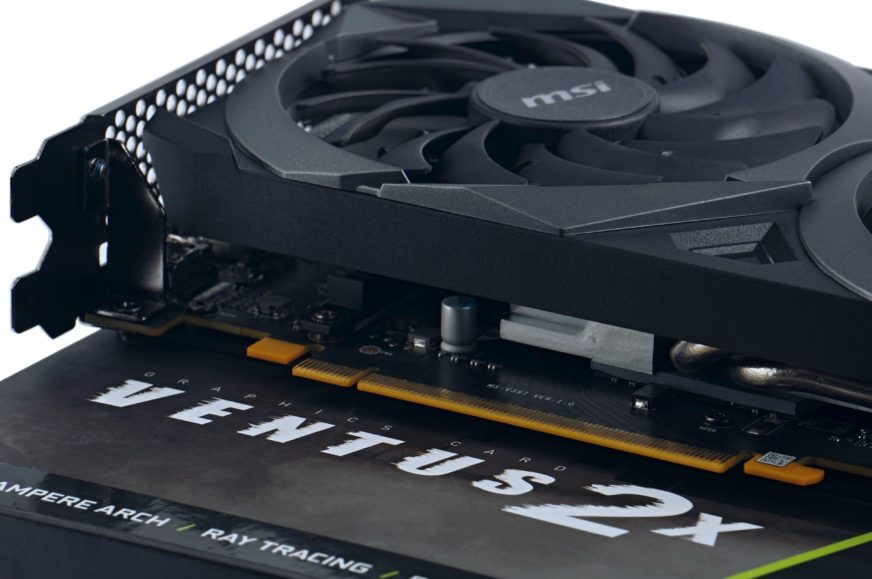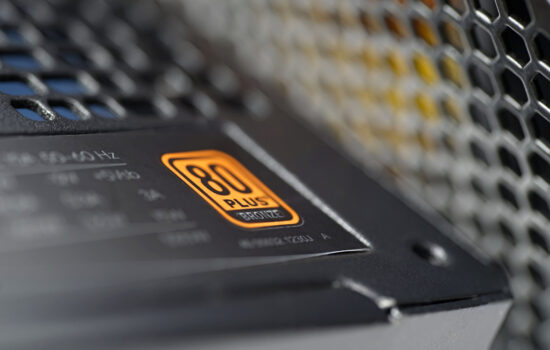Conclusion
In addition to the global price drop on all graphics cards, MSI is now also reducing the MSRP of the RTX 3050 Ventus 2X (OC) from its lowest range. The phrase “affordable graphics card” thus takes on a new spin, and if you’ve read somewhere that the performance characteristics of Ventus graphics cards aren’t worth much, forget it. We certainly don’t see it that way, and few RTX 3050s for this money can boast a more functionally attractive design.
Conclusion
Compared to Radeon RX 6600 XT, RTX 3050’s performance across resolutions is 14–24 % lower (with the biggest difference being in the target Full HD resolution). The gap to the RX 6650 XT is naturally a little more significant, but the performance deficit is adequately reflected by the lower price of the RTX 3050. The performance of the cheapest GeForce GPU (i.e. the one in the RTX 3050) with hardware ray tracing support is optimal up to 1080p resolution, where it keeps fps stably above 60 in most games even at the highest graphics detail settings (except for ray tracing). That’s including Assassin’s Creed: Valhalla, Battlefield V, Control, Mafia: DE, Red Dead Redemption 2 or Shadow of the Tomb Raider.
There are even AAA games where the RTX 3050 has sufficient performance even at 1440p. The list includes DOOM Eternal, F1 2020, Forza Horizon 4 (and hopefully for the latest titles in these racing series…) or Wasteland 3. Less demanding games like CS:GO, FIFA or Age of Empires II: DE are nicely smooth even in Ultra HD (2160p). Anyway, there are also quite a lot of games that can be uncomfortable even in 1080p. That is, assuming you want to stay at high graphical detail and operate without DLSS. Rendering below 60 fps is to be expected in Borderlands 3, in Microsoft Flight Simulator, ale aj in Total War Saga: Troy or in Cyberpunk 2077. In these titles, reducing graphical details or, in the case of Cyberpunk 2077, applying DLSS is essential for a smoother experience. In performance mode (with 50 % scaling in each axis) the game runs stably around 70 fps.
We also looked at the effect of ReSizable BAR activity on performance. In majority of games (Assassin’s Creed: Valhalla, Borderlands 3, Control or Cyberpunk 2077, FIFA 21 and the like), it means 4–5 percent better performance. In Total War Saga: Troy and in Forza Horizon 4 it’s more, 10–11 %. Occasionally, however, there are also performance drops, for example in DOOM Eternal (-7 % at 1080p) or in application environment. Some filters in Photoshop (Fied/Iris Blur or Liquify) may be slower with ReBAR or the Eevee animation renderer in Blender.
Vector graphics in Affinity Photo (which didn’t used to be there) is a hair faster with ReBAR for a change and The drop in gaming fps with screen capture is lower with it as well (which is good), in practice, this is typically a streaming, AMD VCE encoder. The differences are always very small, but there are still some improvements. However, Nvidia’s newer drivers (including the studio ones) have lost Hashcat support, and therefore the RTX 3050 results are missing from the relevant chapter.
Hashcat is not supported by any drivers for RTX 3050, but it does not affect the (de)encryption in other applications. In them everything is fine.
The RTX 3050’s raw performance is admittedly lower than RX 66×0 XT, but outside of OpenCL it is typically a faster graphics card for 3D rendering. Specially when the OptiX API is supported. But even Blender with CUDA with the most widely used Cycles renderer is faster, and at the same time at clearly more favorable performance per watt.RTX 3050’s power efficiency is high overall, even in games – between the RX 6600 XT and RX 6650 XT. And the price/performance ratio is better than with these Radeons. Notably, however, the RTX 3050 Ventus 2X 8G OC graphics card performs at a similar and/or worse level than the RTX 3050 Eagle OC 12G. However, here we need to take into account the efficiency of the cooler, which is significantly higher with the RTX 3050 MSI and among the cheaper series is really excellent.
The cooler is noticeably quieter compared to that on the RTX 3060 Eagle OC 12G Eagle, and it doesn’t even drown out the Sapphire Pulse on the RX 6600 XT by a long shot. Yes, they’re both more powerful graphics cards, but the increase in their power draw (over the RTX 3050 Ventus 2X 8G OC) doesn’t correspond in either case to the increase in noise. The lower noise level is not at the expense of higher temperature. Temperatures are some of the lowest and stay below both of the aforementioned cards, which are noisier. The cooler used (Twin Frozr 7) was not developed by MSI as a low-cost solution, but is based on the high-end Gaming X series from the previous generation of Nvidia Pascal graphics cards. The coils are also super-quiet, so it’s an overall solid design with a higher quality standard than is common in lower-end graphics cards. It’s also worth highlighting the higher clock speeds in games than declared in the specs. Boost GPU is faster by roughly 50–120 MHz (1854–1926 MHz depending on load).
For a PC for casual gaming in Full HD, this is an extremely attractive choice. It’s one of the cheapest options, yet with one of the most efficient (if not the most efficient within the price range) coolers. When the Ventus line comes up for debate in internet discussions, you often see a sort of disrespect. Perhaps also because more powerful GPU coolers on Ventus cards aren’t usually this generously oversized (it’s true that while the TDP of high-end GPUs has been increasing between generations, it’s significantly lower on the RTX 3050 than it is on the RTX 2060 Super, which this cooler is paired with), but that’s most certainly not the case with the RTX 3050.
This graphics card is exceedingly quiet, temperatures are low enough, and the Ventus 2X also has the advantage of a relatively smaller footprint. Unlike the already somewhat unnecessarily oversized three-fan variants, this card also fits into smaller/shorter cases with its space-saving two-slot height, so it doesn’t put too many restrictions for expanding a build with additional cards. The MSI RTX 3050 Ventus 2X 8G is, in short, very reasonably built in all respects, while also maintaining a pleasant price/performance ratio. So we see this as a well-deserved “Smart buy!” award at HWC.
English translation and edit by Jozef Dudáš
| MSI RTX 3050 Ventus 2X 8G OC |
| + Up to 1080p usually sufficient performance even at the highest graphics details |
| + Very attractive price/performance ratio |
| + Low power draw |
| + High efficiency (i.e. high gaming and computing performance per watt)... |
| + ... regardless of the load. Even in video playback and on the web, where the RX 6650 XT has significantly higher power draw |
| + Efficient cooler – quiet operation and low temperature at the same time... |
| + ... coolers of other cards in this class with comparable cooling performance are generally noisier |
| + Exclusive DLSS, CUDA and OptiX support |
| + Dual-slot design and overall smaller footprint |
| - Lower, often insufficient performance for raytracing graphics |
| - No illuminated elements (some might miss them in a gaming PC) |
| Recommended retail price: 369 EUR |
We’ve got the test games from Jama levova
- Contents
- MSI RTX 3050 Ventus 2X 8G OC in detail
- Table of specifications
- Methodology: performance tests
- Methodology: how we measure power draw
- Methodology: noise and sound measurement
- Methodology: temperature tests
- Test rig
- 3DMark
- Age of Empires II: DE
- Assassin’s Creed: Valhalla
- Battlefield V
- Battlefield V with DXR
- Borderlands 3
- Control
- Control with DXR and DLSS
- Counter-Strike: GO
- Cyberpunk 2077
- Cyberpunk 2077 with DLSS
- Cyberpunk 2077 with DXR (and DXR with DLSS)
- DOOM Eternal
- F1 2020
- FIFA 21
- Forza Horizon 4
- Mafia: DE
- Metro Exodus
- Metro Exodus with DXR and DLSS
- Microsoft Flight Simulator
- Red Dead Redemption 2 (Vulkan)
- Red Dead Redemption 2 (Dx12)
- Shadow of the Tomb Raider
- Shadow of the Tomb Raider s DXR
- Total War Saga: Troy
- Wasteland 3
- Overall game performance and performance per euro
- CompuBench (OpenCL)
- SPECviewperf 2020 and SPECworkstation 3
- FLOPS, IOPS and memory speed tests
- 3D rendering 1/2 (LuxMark and Blender@Cycles
- 3D rendering 2/2 (Blender@Radeon ProRender and Eevee)
- Photo editing (Adobe Photoshop, Lightroom and Affinity Photo)
- Broadcasting (OBS and Xsplit)
- Password cracking
- GPU clock speeds
- GPU and VRAM temperatures
- Net GPU power draw and performance per watt
- Analysis of 12 V branch power supply (higher load)
- Analysis of 12 V branch power supply (lower load)
- Analysis of 3,3 V branch power supply
- Noise level
- Frequency response of sound
- Conclusion














Would it be possible to perform thermal tests of the upcoming GPUs using the same noise levels – just like in CPU cooler and fan tests? With the current methodology, there is a multitude of results, but it’s often impossible to decide which result is better. Some GPUs operate at less than 60 degrees (an overkill) but to achieve it, they run twice as loud. The many game noise and thermal tests could be replaced with just coil whine tests, as it changes a lot in different environments (specific game, being in menu/playing).
The original proposal of the test methodology looked exactly as you describe (we obviously have the same taste :)), but we eventually dropped it. There were several reasons for that. But the main reason was time. If I had taken the cooler apart in such detail and tested it in several modes (instead of one) it would have been unmanageable in terms of time. It’s already too much now. With coolers and fans it’s easier, as they are not as complicated devices as graphics cards, where a lot of time is taken up by performance tests.
The time consumption of a single graphics card test in its current form, by our standards for accuracy, is approaching 300 hours of net time. With a more detailed analysis of the cooler, it would be quite a bit more, and in addition to the modes normalized by the various noise levels, we would still need the default one for evaluation in the end, which is based on the video card’s BIOS settings and is key for the vast majority of users.
And then there’s one more thing that causes some risk when testing at fixed noise levels. The GPU temperature is usually significantly lower than the VRAM and memory temperatures, which are quite difficult to keep track of. Sure, hardware monitoring and, in case of critical values, stop the test (typically at low speed) and evaluate it as a failure, but… capacity-wise, we unfortunately can’t afford this marginal type of tests, which have only a very small audience, in the interest of self-preservation. Although personally, I’d love to pursue it. So perhaps sometime in the future when we can afford to split the work between more people.